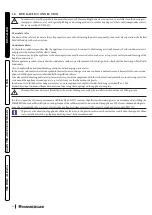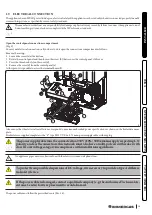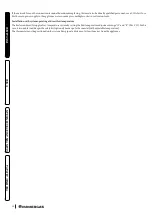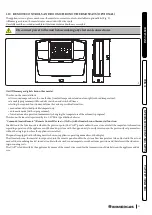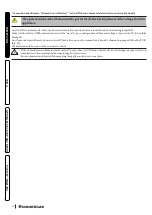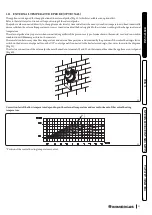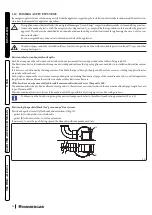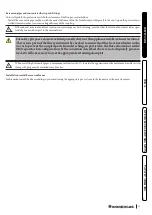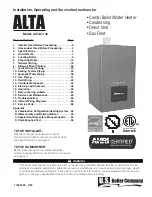
10
INS
TALLER
U
SER
M
AINTEN
AN
CE
TECHNI
CI
AN
TECHNI
CAL
D
AT
A
Wall mounting of the appliance must guarantee stable and efficient support for the generator.
The plugs (standard supply) that come with the appliance are only to be used to fix the latter to the wall; they only ensure adequate support
if inserted correctly (according to technical standards) in walls made of solid or semi-hollow brick or block. In the case of walls made
from hollow brick or block, partitions with limited static properties, or in any case walls other than those indicated, a static test must be
carried out to ensure adequate mount.
These appliances are used to heat water to below boiling temperature in atmospheric pressure.
They must be connected to a central heating system and domestic hot water circuit suited to their performance and capacity.
Risk of damage due to corrosion caused by unsuitable combustion air and environment.
Spray, solvents, chlorine-based detergents, paints, glue, ammonium compounds, powders and similar cause product and flue
duct corrosion.
Check that combustion air power supply is free from chlorine, sulphur, powders, etc.
Make sure that no chemical substances are stored in the place of installation.
If you want to install the product in beauty salons, paint workshops, carpenter’s shop, cleaning companies or similar, choose a
separate installation area that ensures combustion air supply that is free from chemical substances.
Make sure the combustion air is not fed through chimneys that were previously used with boilers or other central heating appli-
ances powered by liquid or solid fuels. In fact, these may cause an accumulation of soot in the chimney
Risk of material damage after using sprays and liquids to search for leaks
Leak sprays and liquids clog the reference hole P.Ref. (Fig. 41) of the gas valve, damaging it irreparably.
During installation and maintenance, do not use spray or liquids in the upper area of the gas valve (side referring to the electric
connections).
Filling the condensate drain trap
When the appliance is switched on for the first time, combustion products come out of the con-
densate drain. After a few minutes of operation, check that combustion flue gases are no longer
coming out of the condensate drain; this means that the drain trap has filled to a correct con-
densate height that the flue gases cannot pass through.
Special provisions for appliances installed in B23 or B53 configuration.
Type B open chamber appliances must not be installed in places where commercial, artisan or
industrial activities take place, which use products that may develop volatile vapours or sub-
stances (e.g. acid vapours, glues, paints, solvents, combustibles, etc.), as well as dusts (e.g. dust
deriving from the working of wood, coal fines, cement, etc.). These may be damaging for the
components of the appliance and jeopardise functioning.


















